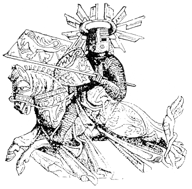Meet the Middle Ages
BackNobility

The aristocracy was very influential during the Middle Ages. A nobleman contributed to the defence of his country by providing soldiers, arms, armour and horses, all in good condition. In return, he did not have to pay any taxes.
About one per cent of the population belonged to the nobility. Within this class, there were large differences. The richest members, the highest nobility, were members of the King ´s Council and made important decisions. They belonged to 20 or so influential families. They strengthened their bonds by arranging advantageous marriages for their children, or by lavish gifts, or by entertaining in splendour. It was very important to attend to and give these banquets in order to make useful contacts. On these occasions, many important decisions were taken.
The lesser nobility did not have as much wealth and power at their disposal. It would often be quite difficult for them to come up with the arms and horses which were demanded for the defence of the country.
The nobleman lived off the produce which came from his estates. The peasants who farmed his land paid a fee to him and owed him labour serviceat his demand. Wealthy noblemen could own hundreds of farms, whilst a person from the lesser nobility perhaps only owned a few.
Once a year, the aristocracy held a meeting to inspect their arms. This would take place in Skara, Linköping, Uppsala or Kalmar. The Royal Bailiff saw to it that the arms, armour and horses were in perfect condition. A nobleman may risk losing his title if his arms etc. were not approved of. These gatherings were festive occasions, with fairs and tournaments.
Throughout the Middle Ages, the King and the Council competed for the power in the country.
Read more about the nobility under "Society Defence", "Town Life The Country around the Town" and "Country Life. Classes of Society"